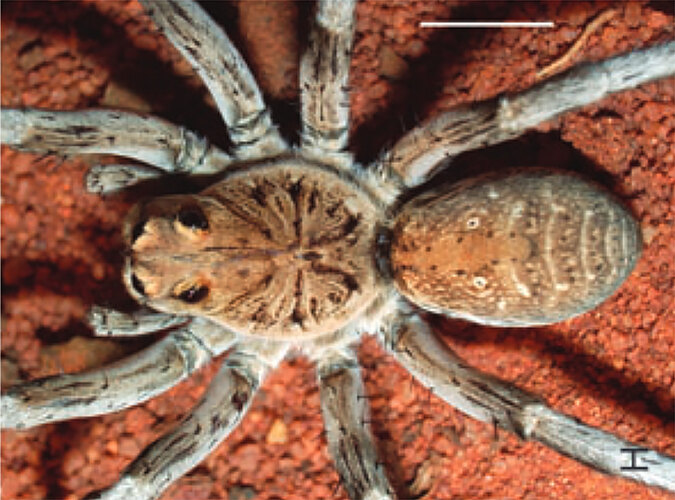Alf's Hoggicosa Hoggicosa alfi Langlands & Framenau, 2010
Fauna Portal species: 6350Diagnosis
(after Langlands & Framenau 2010): Males of Hoggicosa alfi can be distinguished from all other Hoggicosa by the presence of a dark oval patch on the pars pendula and an elongated terminal apophysis which points retrolaterally with only a slight apical bend. Females can be distinguished from all other Hoggicosa by the unique shape of the epigynum, which has broad anterior pockets and a comparatively wide posterior transverse part.
Variation: The tegular apophysis and terminal apophysis of males are somewhat variable within this species. The terminal apophysis of some males points more retrolaterally (little curve apically). The ridge between the ventral process of the tegular apophysis and apical point can also point retrolaterally with little curve. The size of the female epigynum can vary. The opisthosoma of some females may be mottled and darker.
Status
- native
Linnean Holotype
Australia
- New South Wales
- Northern Territory
- Queensland
- South Australia
- Western Australia
Fauna Portal Records
The map shows all records that have been verified as part of the Fauna Portal project and may not represent the true distribution of a species. Specifically, for described species, check the link to the Atlas of Living Australia on this page for potential wider distributions. Fauna Portal Reference specimens and Linnean types are shown in red. If you identified a specimen that exceeds the distribution of an undescribed species as illustrated here, please contact the Fauna Portal team who can assist with the lodgement of the specimen in a public institution and display on the map.
Publications
Langlands P.R. &. Framenau V.W. (2010): Systematic revision of Hoggicosa Roewer, 1960, the Australian 'bicolor' group of wolf spiders (Araneae: Lycosidae). Zoological Journal of the Linnean Society. 158: 83 - 123
Araneae (Spiders)
- Actinopodidae
- Anamidae
- Araneae fam. indet.
- Araneidae
- Archaeidae
- Argyronetidae
- Arkyidae
- Barychelidae
- Cheiracanthiidae
- Clubionidae
- Corinnidae
- Cycloctenidae
- Deinopidae
- Desidae
- Dictynidae
- Filistatidae
- Gnaphosidae
- Halonoproctidae
- Hersiliidae
- Idiopidae
- Lamponidae
- Linyphiidae
- Lycosidae
- Allotrochosina
- Anomalosa
- Artoria
- Artoriopsis
- Costacosa
- Diahogna
- Dingosa
- Genus 2556 (ariadnae grp)
- Genus 3448 (leonhardii gp)
- Genus 3491 (laeta grp)
- Genus 3643 (yalkara grp)
- Hoggicosa
- Hogna
- Kangarosa
- Knoelle
- Kochosa
- Lycosidae gen. indet.
- Mainosa
- Portacosa
- Tapetosa
- Tasmanicosa
- Tetralycosa
- Tuberculosa
- Venator
- Venatrix
- Venonia
- Zoica
- Allotrochosina
- Mimetidae
- Miturgidae
- Mysmenidae
- Nicodamidae
- Oecobiidae
- Oonopidae
- Oxyopidae
- Philodromidae
- Pholcidae
- Pisauridae
- Prodidomidae
- Salticidae
- Scytodidae
- Segestriidae
- Selenopidae
- Sparassidae
- Symphytognathidae
- Tetrablemmidae
- Tetragnathidae
- Theridiidae
- Thomisidae
- Trachelidae
- Trachycosmidae
- Trochanteriidae
- Uloboridae
- Zodariidae
- Zoropsidae
All classes
- Arachnida
- Crustacea
- Entognatha
- Gastropoda
- Insecta
- Blattodea s. str. (Cockroaches)
- Coleoptera (Beetles)
- Dermaptera (earwigs)
- Diptera (flies, mosquitos)
- Entomobryomorpha (slender springtails)
- Hemiptera - Auchenorrhyncha (cicadas, planthoppers)
- Hemiptera - Heteroptera (True Bugs)
- Hemiptera - Sternorrhyncha (aphids, scales etc.)
- Hymenoptera - Formicidae (Ants)
- Hymenoptera excl. Formicidae (bees and wasps)
- Orthoptera - Caelifera (Grasshoppers)
- Trichoptera (Caddisflies)
- Zygentoma (silverfish)
- Myriapoda

